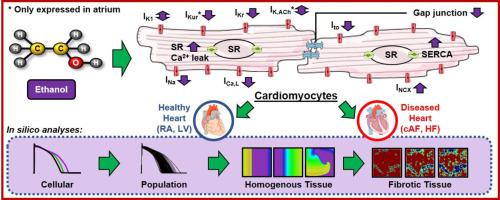Journal of Molecular and Cellular Cardiology ( IF 5 ) Pub Date : 2020-07-22 , DOI: 10.1016/j.yjmcc.2020.07.007 Henry Sutanto 1 , Matthijs J M Cluitmans 1 , Dobromir Dobrev 2 , Paul G A Volders 1 , Markéta Bébarová 3 , Jordi Heijman 1

|
Acute excessive ethyl alcohol (ethanol) consumption alters cardiac electrophysiology and can evoke cardiac arrhythmias, e.g., in ‘holiday heart syndrome’. Ethanol acutely modulates numerous targets in cardiomyocytes, including ion channels, Ca2+-handling proteins and gap junctions. However, the mechanisms underlying ethanol-induced arrhythmogenesis remain incompletely understood and difficult to study experimentally due to the multiple electrophysiological targets involved and their potential interactions with preexisting electrophysiological or structural substrates. Here, we employed cellular- and tissue-level in-silico analyses to characterize the acute effects of ethanol on cardiac electrophysiology and arrhythmogenesis.
Acute electrophysiological effects of ethanol were incorporated into human atrial and ventricular cardiomyocyte computer models: reduced INa, ICa,L, Ito, IKr and IKur, dual effects on IK1 and IK,ACh (inhibition at low and augmentation at high concentrations), and increased INCX and SR Ca2+ leak. Multiscale simulations in the absence or presence of preexistent atrial fibrillation or heart-failure-related remodeling demonstrated that low ethanol concentrations prolonged atrial action-potential duration (APD) without effects on ventricular APD. Conversely, high ethanol concentrations abbreviated atrial APD and prolonged ventricular APD. High ethanol concentrations promoted reentry in tissue simulations, but the extent of reentry promotion was dependent on the presence of altered intercellular coupling, and the degree, type, and pattern of fibrosis.
Taken together, these data provide novel mechanistic insight into the potential proarrhythmic interactions between a preexisting substrate and acute changes in cardiac electrophysiology. In particular, acute ethanol exposure has concentration-dependent electrophysiological effects that differ between atria and ventricles, and between healthy and diseased hearts. Low concentrations of ethanol can have anti-fibrillatory effects in atria, whereas high concentrations promote the inducibility and maintenance of reentrant atrial and ventricular arrhythmias, supporting a role for limiting alcohol intake as part of cardiac arrhythmia management.
中文翻译:

酒精对心脏电生理和心律失常的急性影响:多尺度计算机分析的见解。
急性过量摄入乙醇(乙醇)会改变心脏电生理,并可能引起心脏心律不齐,例如在“假日心脏综合征”中。乙醇可急性调节心肌细胞中的许多靶标,包括离子通道,Ca 2+处理蛋白和间隙连接。然而,由于所涉及的多个电生理学靶标及其与先前存在的电生理学或结构底物的潜在相互作用,乙醇诱导的心律失常发生的机制仍未完全理解,并且难以进行实验研究。在这里,我们采用了细胞和组织水平的计算机模拟分析来表征乙醇对心脏电生理和心律失常的急性影响。
乙醇的急性电生理作用已纳入人心房和心室心肌细胞计算机模型:降低了I Na,I Ca,L,I至,I Kr和I Kur,对I K1和I K,ACh的双重作用(低抑制和增强在高浓度下),并增加I NCX和SR Ca 2+泄漏。在不存在或存在房颤或与心力衰竭相关的重塑的情况下进行的多尺度模拟表明,低乙醇浓度会延长心房动作电位持续时间(APD),而不会影响心室APD。相反,高乙醇浓度缩写为心房APD和延长的心室APD。高乙醇浓度会在组织模拟中促进折返,但是折返促进的程度取决于细胞间偶联改变的存在以及纤维化的程度,类型和模式。
综上所述,这些数据为预先存在的底物与心脏电生理的急性变化之间潜在的心律失常相互作用提供了新颖的机理见解。尤其是,急性乙醇暴露具有浓度依赖性的电生理效应,在心房和心室之间以及健康和患病的心脏之间存在差异。低浓度的乙醇可对心房产生抗纤颤作用,而高浓度的乙醇可促进折返性房性和室性心律失常的诱导和维持,支持限制酒精摄入作为心律失常管理的一部分。


























 京公网安备 11010802027423号
京公网安备 11010802027423号